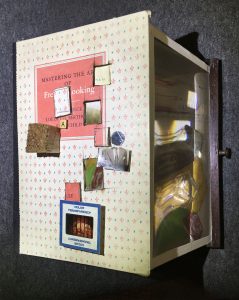
A Perspective on the Cabinet of (in)Curiosities, by Axel Fussi
“This is what is known as perspective, and it is a swindle….” Kurt Schwitters
The unique format of Doctor Kali Gehry’s Cabinet of (in)Curiosities & Ecstatic Nonsense provides for a dynamic and momentarily baffling field of contemplation, interaction, and interrogation that invites an audience to ask questions about what and how they see. In this Neo- Dada work, these nonsensically reconfigured objet trouvés create, as André Breton put it, “veritable slits in time, space, customs and even beliefs.” In this sense, this cabinet is intended to be by turns affirmative and interrogative. In doing so, the spectators begin to interrogate their very relationship with the Cabinet’s collection, and, therefore, themselves.
This cabinet is architecturally mutable, a pop-up of discards, housed intermittently in local Low Street shopping malls, neglected Main Streets, interstitial commercial, institutional or public spaces. Though the cabinet’s architecture seems poised, simultaneously it seems at the risk of tipping and sliding toward instability. The individual cabinets themselves are stable and level, with their contents seemingly arranged to whim – paradoxically linked by the absence of any discernible link. Like Schwitter’s Merzbau, it is a chamber whose construction and commencement of destruction are indiscernible, an endless laborious production and self-effacing unmoored from any claims to a definitive outcome.
The work deploys an organizing principle of movement, collision and juxtaposition, where one’s perambulating and shifting gaze sequence the exhibition as it unfurls, inviting an intrinsically variable interpretation of the work’s significance. A seemingly absurd individual thing surprises by revealing its agency within the peculiar grammar of the collage precisely due to the contingencies and juxtapositions of an infinite number of combinatory possibilities it is exposed to. One wonders about the cabinet contents’ aleatory provenance, the chances of these object fragments being seen and picked up by the artist, their seemingly arbitrary mise-en-scene and mise-en-place, indiscriminate of any assertions of completion.
Though the re-exalted contents of this oddity store are not for sale – thus questioning their value, if there should be any at all – the curating restores what many would simply see as refuse to a more refined status of significance. As signs, visual metaphors, in tandem with their aesthetic uniqueness, and residual significance, these fragments of detritus are still identifiable – their origins largely traceable to their former contexts. Yet, when isolating and alienating these object fragments from the rationality and legitimacy they derived from their “native” context, once recombined, they reveal their surprising inherent and emerging, yet nevertheless absurd alliances.
Via the exhibits’ explicit framings, portals, screens and illuminated lenses, we are led back to the idea of Point of View, the very root of perspective, as a human-centric view of things, with the world converging in and radiating from its inevitably banal centre. Spectators are thrown back on themselves, by becoming involved in this rather confusing and disconcerting process, since the world’s order is jarringly disrupted. For the audience, this loss of perspective ineluctably entails finding themselves in the present, in the here and now.
Being present in the presence of these momento mori constructions, we are challenged to confront the ephemerality of things, and thus the vanity of our own existence. This is similar to being presented with a Koan, the old hat trick of Zen masters, handed with the intent to blow all rational constructs of “truth” in their disciples’ minds to smithereens, and thus open their hearts to the unspeakable.